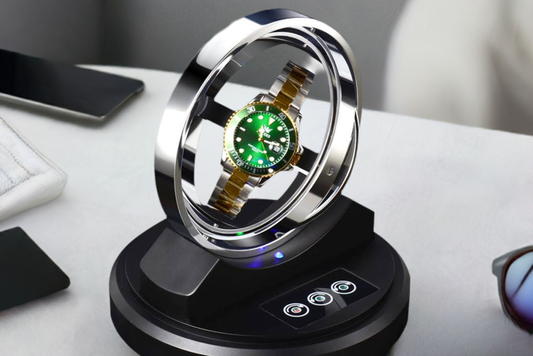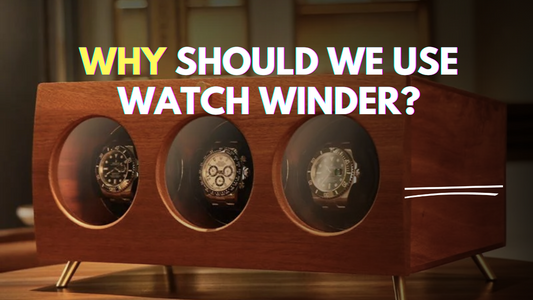Automatic and self-winding watches have long captivated watch enthusiasts with their intricate mechanisms and timeless charm. While often used interchangeably, these terms refer to the same type of watch that harnesses the wearer's motion to power itself. In this article, we'll delve into the fascinating world of automatic watches, exploring their inner workings, advantages, and the unique appeal they hold for collectors and enthusiasts alike.
The Heart of the Matter: Automatic vs. Self-Winding
Despite the common misconception, self-winding watches are not a separate category from automatic watches. In fact, they are one and the same. Both types of watches utilize the wearer's movement to generate energy, eliminating the need for manual winding or battery replacements. The key difference lies in the mechanism that powers these timepieces.
Understanding Mechanical Watches
At the core of automatic and self-winding watches are mechanical movements. These intricate mechanisms rely on the force of a coiled spring, known as the mainspring, to power the watch. As the mainspring unwinds, it releases energy through a gear train to the escapement and balance wheel, which regulate the release of stored energy in precise increments. This process ultimately drives the watch's hands, keeping accurate time.
The distinction between manual and automatic watches lies in how the mainspring is wound. Manual watches require the wearer to physically turn the crown to wind the mainspring, while automatic watches harness the wearer's motion to do so.
Credit: YouTube Channel - Brock McGoff
The Distinction Between Automatic and Self-Winding Watches
As mentioned earlier, "automatic" and "self-winding" are interchangeable terms referring to the same type of watch. These timepieces feature a rotor, typically a semi-circular metal weight, that oscillates with the wearer's movements. As the rotor spins, it winds the mainspring, continuously storing energy to power the watch. As long as the watch is worn regularly, it will maintain its power reserve and accuracy.
Market and Industry Perspective
The demand for automatic mechanical watches continues to grow, with the market projected to reach USD XX Million by 2031. This growth is fueled by the enduring appeal of mechanical watches, which offer a unique blend of craftsmanship, history, and romance. Despite the challenges posed by quartz and smartwatches, the mechanical watch industry has adapted and thrived, maintaining its relevance in the ever-evolving world of horology.
Examples of Affordable Automatic Watches
For those looking to enter the world of mechanical watches without breaking the bank, there are several affordable options available. The Timex Marlin, a manually wound watch, offers a 34mm case, 10mm thickness, and a reliable Seagull movement for just $199. Another excellent choice is the Orient watch, which features a 40mm case, 13mm thickness, and an Orient 48C40 movement, all for a price range of $400-$500.
Mechanisms Unveiled: How They Work
Automatic Watches
The ingenious mechanism behind automatic watches is a marvel of horological engineering. At the heart of these timepieces lies the rotor, a weighted half-moon-shaped component that oscillates with the wearer's wrist movements. As the rotor rotates, it winds the mainspring, which powers the watch's gears and hands. This process is made possible by a complex system of gears and levers that convert kinetic energy into mechanical energy.
For instance, the Rolex Perpetual rotor, found in many of the brand's automatic models, is designed to wind the watch in both directions, ensuring that even the slightest wrist movements contribute to powering the watch. This efficient design allows automatic watches to maintain their power reserve for extended periods, often several days, without the need for manual winding.
Manual Winding Watches
While the term "self-winding" is sometimes used to describe manual winding watches, it is a misnomer. Manual winding watches require the wearer to physically wind the mainspring using the crown, typically on a daily basis. This process involves turning the crown clockwise to tighten the mainspring, storing energy that is gradually released as the watch runs.
The frequency and duration of winding depend on the specific watch model and its power reserve. For example, the iconic Omega Speedmaster Professional, a manual winding watch, requires daily winding to maintain its 48-hour power reserve. This hands-on interaction fosters a unique connection between the wearer and their timepiece, appealing to those who appreciate the traditional and tactile nature of mechanical watches.
Advantages and Disadvantages
Automatic Watches
Advantages:
- Convenient and low-maintenance, as they don't require manual winding or battery replacements
- Suitable for daily wear, as the wearer's movements continuously power the watch
- Often feature a power reserve, allowing the watch to run for several days without being worn
Disadvantages:
- May require more frequent servicing due to the complexity of the self-winding mechanism
- Can be slightly heavier than manual winding watches due to the added weight of the rotor
- Power reserve may deplete if the watch is not worn regularly
Manual Winding Watches
Advantages:
- Often feature a simpler mechanism, making them easier to service and maintain
- Provide a tactile and engaging experience, as the wearer must manually wind the watch
- Typically thinner and lighter than automatic watches, as they lack the self-winding mechanism
Disadvantages:
- Require daily winding to maintain accuracy and power reserve
- May be less convenient for those who prefer a "set it and forget it" approach to timekeeping
- Power reserve is typically shorter than that of automatic watches
Choosing the Right Watch for Your Lifestyle
Active Wearers
For individuals with active lifestyles, automatic watches are an excellent choice. These timepieces are designed to harness the wearer's movements, ensuring a continuous power supply as long as the watch is worn regularly. Popular automatic watches for active wearers include the Omega Seamaster Planet Ocean, Rolex Submariner, and Breitling Navitimer, all of which feature robust construction, water resistance, and precise timekeeping.
Traditionalists and Collectors
Manual winding watches hold a special appeal for those who value horological heritage and a hands-on experience. The act of winding the watch daily creates a intimate connection between the wearer and their timepiece, fostering a deep appreciation for the craftsmanship and mechanics involved. Sought-after manual winding watches include the Patek Philippe Calatrava, Vacheron Constantin Patrimony, and Audemars Piguet Royal Oak, all renowned for their exquisite design and precise timekeeping.
Maintenance and Longevity
Proper care and maintenance are essential for ensuring the longevity of both automatic and manual winding watches. On average, automatic watches require servicing every 5-10 years, while manual winding watches may need attention every 3-5 years. The cost of servicing can vary significantly depending on the brand, model, and complexity of the movement, ranging from a few hundred to several thousand dollars.
To extend the life of your timepiece, follow these tips:
- Avoid exposing your watch to extreme temperatures and magnetic fields
- Keep your watch clean and dry, using a soft cloth to wipe away dirt and moisture
- Store your watch properly when not in use, ideally in a watch box or soft pouch
- Adhere to the recommended servicing intervals to keep your watch in optimal condition
The Aesthetics Factor
The visual appeal of automatic and manual winding watches is a matter of personal preference. Manual winding watches often showcase their intricate inner workings through a transparent case back, allowing the wearer to admire the watchmaker's artistry and attention to detail. Automatic watches, on the other hand, tend to have a more streamlined and minimalist design, with the rotor hidden from view.
Some watch enthusiasts prefer the connection and appreciation that comes with manually winding their timepiece, while others appreciate the convenience and simplicity of an automatic watch. Ultimately, the choice between these two types of watches comes down to individual taste and the level of involvement one desires in the timekeeping process.
Resale Value and Collectibility
Several factors influence the resale value and collectibility of automatic and manual winding watches, including:
- Rarity: Limited edition or discontinued models from prestigious brands tend to retain their value better than mass-produced watches.
- Brand: Luxury brands such as Patek Philippe, Rolex, and Audemars Piguet are highly sought-after by collectors and often command higher resale prices.
- Movement: Watches with intricate mechanical movements, particularly those with complications like tourbillons or minute repeaters, are prized by collectors for their craftsmanship and complexity.
Collectors often gravitate towards manual winding watches due to their connection to traditional watchmaking and the artistry involved in their creation. However, high-end automatic watches from esteemed brands can also be highly collectible and valuable.
Conclusion
In the end, the choice between an automatic and manual winding watch is a deeply personal one, reflecting your lifestyle, appreciation for craftsmanship, and the emotional connection you seek with your timepiece. By understanding the intricacies of these mechanisms, their advantages and disadvantages, and the factors that influence their value and collectibility, you can make an informed decision that resonates with your horological heart.
Whether you opt for the convenience of an automatic watch or the hands-on experience of a manual winding timepiece, you'll be embracing the essence of mechanical watchmaking – a world where artistry, precision, and passion intertwine to create timeless masterpieces.
We hope this in-depth exploration of automatic and manual winding watches has provided you with valuable insights and helped you appreciate the rich history and craftsmanship behind these incredible timepieces. If you have any further questions or would like to share your own experiences with automatic or manual winding watches, please feel free to leave a comment below. Don't forget to share this article with your fellow watch enthusiasts and collectors!
Frequently Asked Questions
1. Are automatic watches more accurate than manual winding watches?
In terms of accuracy, there is no inherent difference between automatic and manual winding watches. The accuracy of a mechanical watch depends on factors such as the quality of the movement, the skill of the watchmaker, and the level of maintenance the watch receives. Both automatic and manual winding watches can be highly accurate when properly cared for and serviced regularly.
However, it's worth noting that the self-winding mechanism in automatic watches can help maintain a more consistent power reserve, which may contribute to better overall accuracy. As long as an automatic watch is worn regularly, it will continue to run without the need for manual winding, reducing the chances of the watch stopping and potentially affecting its accuracy.
2. Can I manually wind an automatic watch?
Yes, most automatic watches can be manually wound using the crown. This is particularly useful if the watch has not been worn for an extended period and has depleted its power reserve. To manually wind an automatic watch, simply unscrew the crown (if it is a screw-down crown) and turn it clockwise until you feel resistance. This process will wind the mainspring and provide the watch with enough power to start running.
It's important to note that over-winding an automatic watch is generally not a concern, as most modern automatic movements feature a slipping clutch mechanism that prevents damage from excessive winding. However, it's always a good idea to consult your watch's user manual or a professional watchmaker for specific guidance on winding your particular timepiece.

![[2024]Self-Winding vs. Automatic Watches: Key Differences](http://uroro.com/cdn/shop/articles/youtube_thumbnail_2_3.webp?v=1717223222&width=1100)


